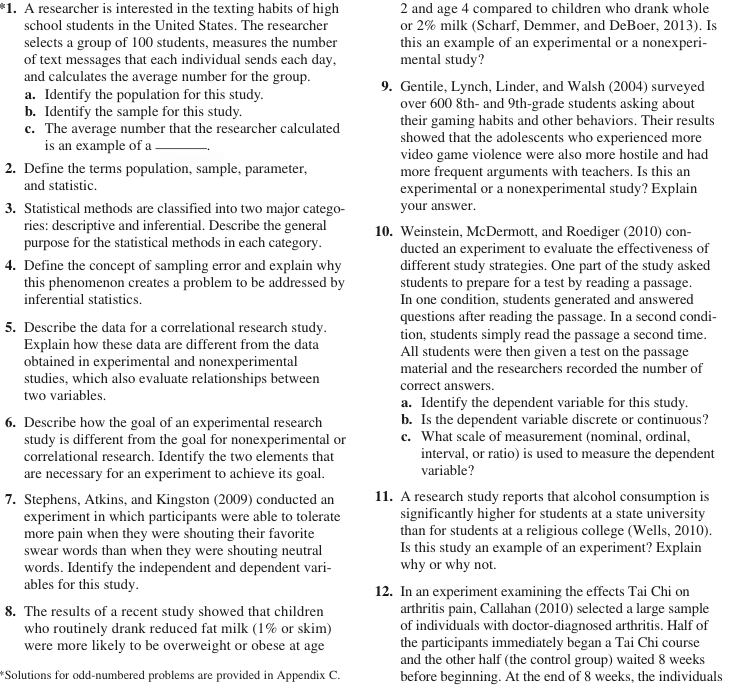2 and age 4 compared to children who drank whole or 2% milk (Scharf, Demmer, and DeBoer, 2013). Is this an example of an experimental mental study? *1. A researcher is interested in the texting habits of high school students in the United States. The researcher nonexperi selects a group of 100 students, measures the number of text messages that each individual sends each day and calculates the average number for the group a. Identify the population for this study b. Identify the sample for this study c. The average number that the researcher calculated is an example of a . 2. Define the terms population, sample, parameter and statistic or a 9. Gentile, Lynch, Linder, and Walsh (2004) surveyed over 600 8th- and 9th-grade students asking about their gaming habits and other behaviors. Their results showed that the adolescents who experienced more video game violence were also more hostile and had more frequent arguments with teachers. Is this an experimental or a nonexperimental study? Explain your answer 10. Weinstein, McDermott, and Roediger (2010) con ducted an experiment to evaluate the effectiveness of different study strategies. One part of the study asked students to prepare for a test by reading a passage In one condition, students generated and answered questions after reading the passage. In a second condi- tion, students simply read the passage a second time All students were then given a test on the passage 3. Statistical methods are classified into two major catego- ries: descriptive and inferential. Describe the general purpose for the statistical methods in each category 4. Define the concept of sampling error and explain why this phenomenon creates a problem to be addressed by inferential statistics 5. Describe the data for a correlational research study Explain how these data are different from the data obtained in experimental and nonexperimental studies, which also evaluate relationships between two variables material and the researchers recorded the number of correct answers a. Identify the dependent variable for this study b. Is the dependent variable discrete or continuous? c. What scale of measurement (nominal, ordinal interval, or ratio) is used to measure the dependent variable? 6. Describe how the goal of an experimental research study is different from the goal for nonexperimental or correlational research. Identify the two elements that are necessary for an experiment to achieve its goal 7. Stephens, Atkins, and Kingston (2009) conducted an experiment in which participants were able to tolerate more pain when they were shouting their favorite swear words than when they were shouting neutral words. Identify the independent and dependent vari- ables for this study 11. A research study reports that alcohol consumption is significantly higher for students at a state university than for students at a religious college (Wells, 2010) Is this study an example of an experiment? Explain why or why not. 12. In an experiment examining the effects Tai Chi on arthritis pain, Callahan (2010) selected a large sample of individuals with doctor-diagnosed arthritis. Half of the participants immediately began a Tai Chi course and the other half (the control group) waited 8 weeks before beginning. At the end of 8 weeks, the individuals 8. The results of a recent study showed that children who routinely drank reduced fat milk (1% or skim) were more likely to be overweight or obese at age Solutions for odd-numbered problems are provided in Appendix C.
Unitary Method
The word “unitary” comes from the word “unit”, which means a single and complete entity. In this method, we find the value of a unit product from the given number of products, and then we solve for the other number of products.
Speed, Time, and Distance
Imagine you and 3 of your friends are planning to go to the playground at 6 in the evening. Your house is one mile away from the playground and one of your friends named Jim must start at 5 pm to reach the playground by walk. The other two friends are 3 miles away.
Profit and Loss
The amount earned or lost on the sale of one or more items is referred to as the profit or loss on that item.
Units and Measurements
Measurements and comparisons are the foundation of science and engineering. We, therefore, need rules that tell us how things are measured and compared. For these measurements and comparisons, we perform certain experiments, and we will need the experiments to set up the devices.
number 9

Trending now
This is a popular solution!
Step by step
Solved in 2 steps


